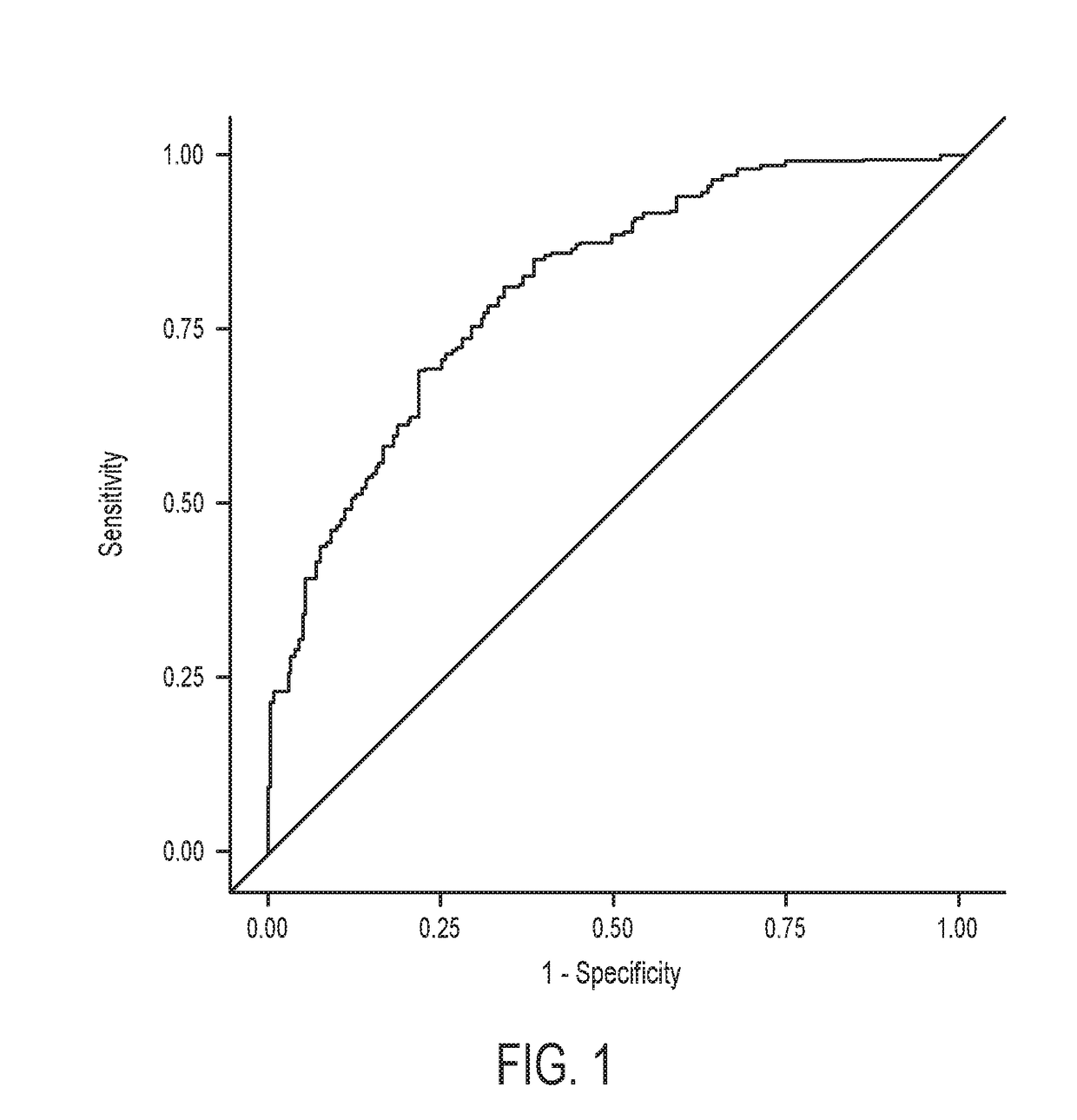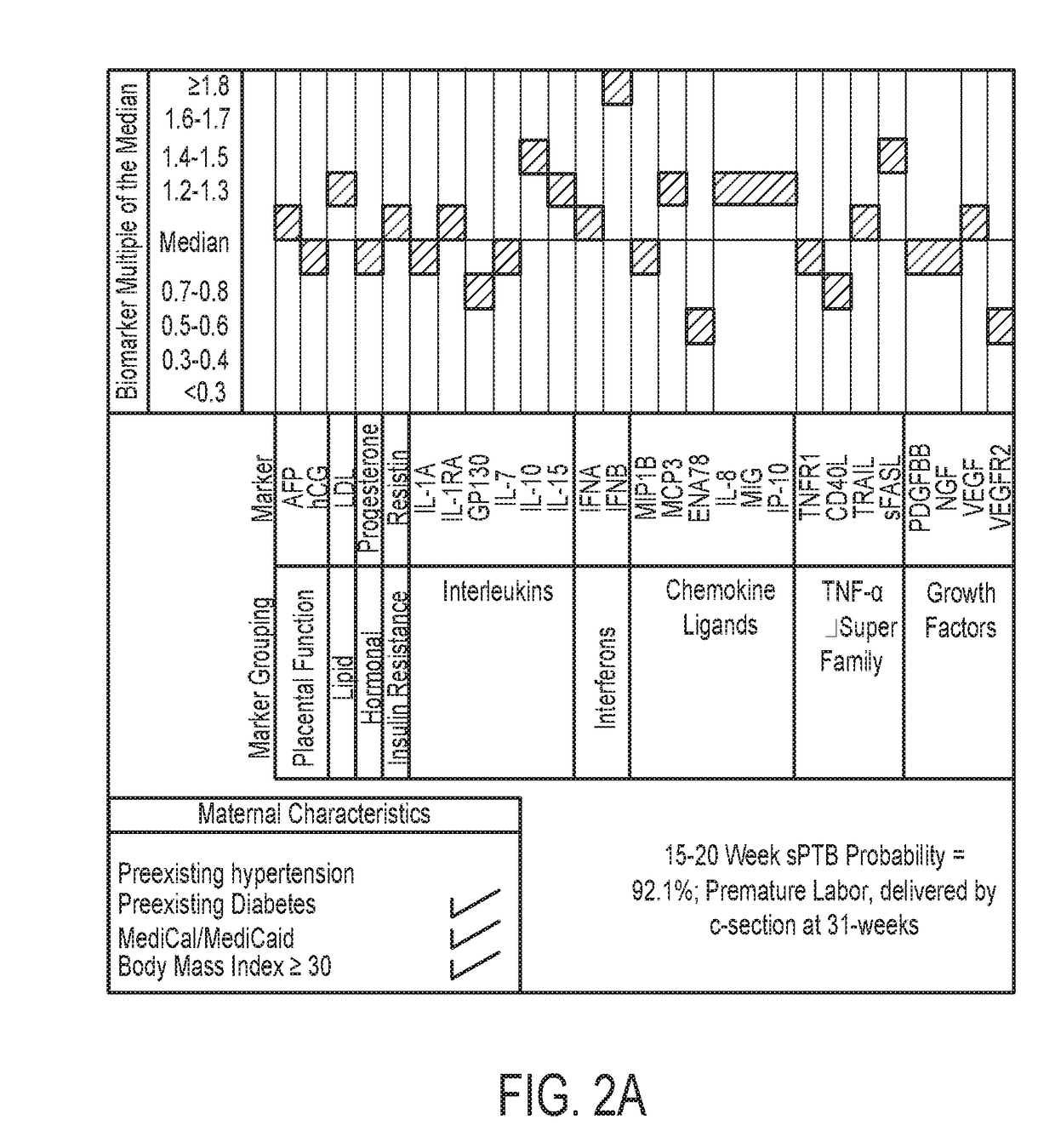Tools for Predicting the Risk of Preterm Birth
a preterm birth and risk technology, applied in the field of preterm birth risk prediction tools, can solve the problems of few mid-pregnancy tools for predicting preterm birth risk, inability to understand the underlying causes of ptb, life-long disability and health challenges of survivors, etc., to reduce such risks, avoid invasiveness, and improve the effect of ptb risk assessmen
- Summary
- Abstract
- Description
- Claims
- Application Information
AI Technical Summary
Benefits of technology
Problems solved by technology
Method used
Image
Examples
example 1
Generation of Model 1 and Panel A
[0082]Model 1 was generated using multivariate backward stepwise logistic regression with consideration of two-way interactions. Four markers related to placental function were tested prospectively and 69 lipid-, hormone-, and immune-related markers in banked 15-20 gestational week serum samples collected as part of routine prenatal screening in 200 women with spontaneous PTB (100<34 weeks, 100 34-36 weeks) and 200 term controls.
[0083]So as not to lose critical information, the area under the curve (AUC) statistic was used for model selection with entry set at p<0.20 and exclusion of additional factors where AUC reduction was <0.01 after removal. Model fit was tested using a Hosmer-Lemeshow goodness of fit test. Bootstrapping with replacement was used to assess replicability (n=500 replicates).
[0084]Results: The model generation step identified the risk indicators of Panel A to be predictive of PTB. The resulting Model 1 is able to identify >80% of w...
example 2
Derivation of Panel B
[0086]A subset of singleton pregnancies with prospectively measured first and second trimester serum markers available was selected. For this study 200 cases were randomly selected for closer analyses and potential specimen pulling. 173 pregnancies resulting in PTBs (74 PPROM, 99 premature labor) were selected. Controls were randomly selected at a ratio of 1:1 from the term births with frequency matching of cases and controls on body mass index (BMI) at or above 30.
[0087]Maternal indicators analyzed included race / ethnicity, maternal age, parity, preexisting diabetes, gestational diabetes, preexisting hypertension, gestational hypertension, reported smoking, participation in government health assistance for low income persons, and previous PTB.
[0088]BioMarkers examined included those tested prospectively as part of routine first and second trimester prenatal screening and markers tested on serum banked after screening. Prospectively measured first trimester analy...
example 3
Derivation of Panel C
[0094]In this, further elucidation of PTB risk indicators was performed.
[0095]Subjects: 346 singleton pregnancies without aneuploidy with expected dates of delivery in 2009 and 2010 (n=173 cases (early spontaneous PTB<32 weeks) and n=173 controls).
[0096]Biomarker Measurement: Six markers related to placental function were tested prospectively. 75 lipid and immune related markers were tested on banked second trimester (15-20 week) samples.
[0097]Model Generation: Cases and controls were divided into training and testing sets at a ratio of 3:1. Linear Discriminate Analyses (LDA) was used to identify markers in the training set that significantly contributed to sorting cases from controls. Performance of the LDA derived model was tested in both the training and testing subsets.
[0098]Results and Conclusions: The seventeen markers of Panel C were included in the final LDA model (17 out of the 81 considered). Detection in the training set was 81.74% (area under the cur...
PUM
| Property | Measurement | Unit |
|---|---|---|
| body mass index | aaaaa | aaaaa |
| concentration | aaaaa | aaaaa |
| fluorescence intensity | aaaaa | aaaaa |
Abstract
Description
Claims
Application Information
 Login to View More
Login to View More - R&D
- Intellectual Property
- Life Sciences
- Materials
- Tech Scout
- Unparalleled Data Quality
- Higher Quality Content
- 60% Fewer Hallucinations
Browse by: Latest US Patents, China's latest patents, Technical Efficacy Thesaurus, Application Domain, Technology Topic, Popular Technical Reports.
© 2025 PatSnap. All rights reserved.Legal|Privacy policy|Modern Slavery Act Transparency Statement|Sitemap|About US| Contact US: help@patsnap.com



